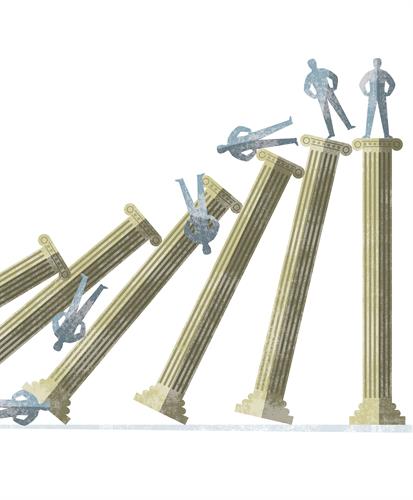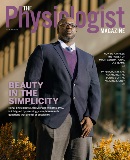The Physiologist Magazine
Read the Latest Issue
Don’t miss out on the latest topics in science and research.
View the Issue Archive
Catch up on all the issues of The Physiologist Magazine.
Contact Us
For questions, comments or to share your story ideas, email us or call 301.634.7314.
Reconciling Legacy
How academic institutions and science can handle important work by historical figures with complicated lives.
By Brittany King

Statues of Confederate Army leaders have fallen in the U.S. Academic halls have been stripped of the names of those who enslaved people. Former iconic figures have had their legacies questioned. Across science and medicine, academics, physicians and students have grappled with whether and how a person’s work can be praised, even memorialized, without taking a deeper look into who they were and what they stood for.
In an era of movements such as #MeToo and Black Lives Matter, questions have been raised about the best way to address the work of historical figures with complicated pasts. In physiology, this includes the legacy of William Beaumont.
A U.S. Army surgeon known as the “Father of Gastric Physiology,” Beaumont performed his landmark gastrointestinal research on Alexis St. Martin, a white fur trapper who was shot in the stomach. The unusual way St. Martin’s wound healed—into a fistula that allowed a literal “window” into how digestion worked—led to a relationship between the two men in which Beaumont kept St. Martin as an indentured house servant by day and an experimental subject at night. Today, many recognize Beaumont’s work as groundbreaking but also unethical. How can we reconcile that and other similar examples?
The Physiologist Magazine spoke with Joanna Radin, PhD, associate professor of history of medicine at Yale University, New Haven, Connecticut.
TPM: How can the medical field reconcile problematic achievements such
as Beaumont’s?
JR: It’s a really good and relevant question for Yale. One of the main meeting rooms, the heart of the Yale Medical School, is called the Beaumont Room, and there’s a painting in there that
depicts aspects of this relationship, but in ways that aren’t terribly illuminating about St. Martin’s life. There are a lot of meetings that happen in the Beaumont Room, from faculty orientation to lectures about race and activism. It
would be wonderful for the artwork in that room to be contextualized such that it raises awareness and encourages reflection about the kinds of exploitative relationships that have too often characterized medical experimentation.
There is a new committee on art in public spaces at the medical school which has been created for precisely this reason. A number of graduate students trained in medical history will be helping the dean to rethink how Yale represents itself and its relationship to uncomfortable aspects of its past.
Personally, I feel it is unacceptable to celebrate accomplishments of physicians without devoting attention to the humans upon whose bodies these accomplishments have been made possible, especially when those accomplishments are the product of coercion or exploitation.
The point is not to say, ‘let’s cancel all of medicine.’ I’m a historian, so I think it matters that people know how they came to know what they know. Too often, there’s a temptation to think ‘these are things that
happened a long time ago when we didn’t know better.’ But what I’ve learned from historical research is that someone always knew better; there have always been people who see what is happening around them and attempt to resist or
refuse. You don’t have to look very hard to find even members of the profession who at the time said, ‘this is racist, this is harmful, this is going to come back and haunt us.’ The question is why those voices are not, and were
not, powerful enough to prevent harm. It’s something that I really struggle with and I’m deeply interested in understanding. The challenge of the present is learning how to identify, amplify and listen to those voices.
TPM: Is there harm in naming an award, building, etc. after people who have caused pain to communities?
JR: Yes. I don’t see any reason why people who have done violence need to be memorialized—especially without
awareness of their actions. The purpose of monuments and statues and memorialization is to force us to reckon with these issues and the ways in which our society has changed or hasn’t changed. We need to think hard about what it has meant to
have systems of higher education built on racial capital. As a historian, I don’t think is antithetical to history to having reckonings around these buildings or to rename them. After all, the goal of history is to reckon with change over time.
TPM: What’s the solution to honoring people who have done important work but have a complicated past?
JR: We need to honor more of the story. Only if we understand more fully the circumstances
under which knowledge gets made can we make better choices as individuals and as a society.
One thing I really believe strongly is that since science and medicine are human activities, that they are done by people, it is up to those people to
make choices about what they value. The ways in which knowledge is made has profound consequences about who gets to benefit from that knowledge.
TPM: What are you teaching at Yale right now? How has that changed in
light of COVID-19, the Black Lives Matter movement and other movements fighting social injustice?
JR: This fall, I’m teaching “historical perspectives on global health,” which is very relevant.
We examine how ideas about disease, colonialism, race, gender, science, diplomacy, security and economics have shaped and been shaped by the attempts to negotiate problems of health that transcend geopolitical borders. We consider the impact of both
successful and unsuccessful attempts to manage health and illness, as well as the lived experience of such attempts in local contexts.
I’m also interested in the history of humanitarianism. That includes asking questions about what it means to help, who gets to decide what counts as a problem for global health and who gets to decide what kind of solutions we come up with.
TPM: How is this moment changing how you approach lectures? Additionally, how can educators allow current events to shape class discussions?
JR: That is a big question. In a lot of ways, even before
racism made headlines this spring, I started to shift my pedagogy to create a classroom that was more attentive to diversity. In my teaching in Yale College and its Graduate School of Arts and Sciences, I work with students that come from a variety
of backgrounds. I realized that if we don’t know where each other are coming from, then we are all going to be setting ourselves up for missed communication and missed opportunity. I try to provide ways for students to articulate what’s
on their mind and what their questions and concerns are.
For the medical students I teach, I have observed that they have had the benefit of taking classes during their undergraduate careers that were not offered when their professors were going through school, including history of medicine. These students
are equipped with intellectual and political resources that many of their professors have not been exposed to. Faculty are increasingly learning from their students—both about the kinds of topics they want to see better represented in the medical
curriculum as well as how to address questions of racism, sexism, ableism and other forms of inequality in constructive ways. As faculty, we all benefit from being willing to work with students to figure out how to make our teaching more attentive
to a greater variety of lives.
TPM: What can administrations do to help facilitate this?
JR: I’ve been at Yale for almost a decade, and there are extraordinary people doing
health-related work within the community. Unfortunately, many of them are disenfranchised from the resources of the university. Many of the students have pointed out that Yale can do more to better engage with and address the needs of the community
upon which the university relies. New Haven is a city that struggles with racial and economic inequality, which is directly tied to health outcomes. When medical students are supported in taking the needs of the community in which they are training
seriously, they will be better equipped to serve their patients no matter where their careers take them. It might even encourage them to develop innovative research agendas that situate patients as partners rather than subjects.
Joanna Radin, PhD, is associate professor of history of medicine at Yale University, New Haven, Connecticut. She describes herself as “a historian of biomedical futures, with a focus on how people since World War II have imagined life science, genetics and epidemiology would change their lives.”
This article was originally published in the November 2020 issue of The Physiologist Magazine.
“You don’t have to look very hard to find even members of the profession who at the time said, ‘this is racist, this is harmful, this is going to come back and haunt us.’ The question is why those voices are not, and were not, powerful enough to prevent harm.”
Joanna Radin, PhD


